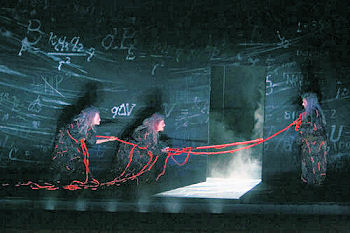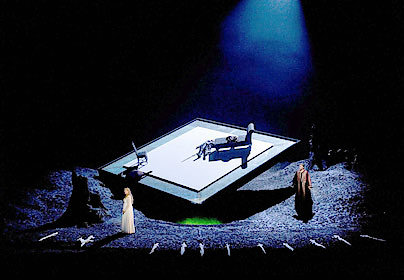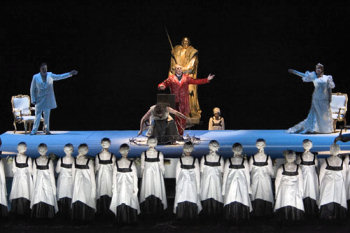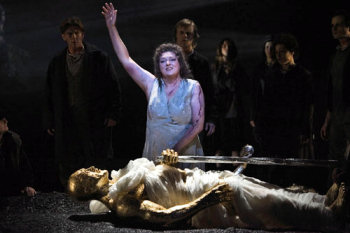Wagner, Götterdämmerung:
soloists and orchestra of the Royal Opera House, Antonio
Pappano (conductor), Keith Warner (director), Stefanos
Lazaridis (sets), Marie-Jeanne Lecca (costumes), Wolfgang
Göbbel (lighting), Royal Opera House, Covent
Garden, 17.4.2006 (JPr)

Keith Warner concludes his new Ring
cycle at Covent Garden and leaves us little wiser
as to his ‘vision’ than when he began
Das Rheingold. Certainly compared to that Rheingold
and Die Walküre, this Götterdämmerung
is generally a clutter-free zone. The sets are very
spare and there are lots of clean vertical and horizontal
lines, as well as the large rectangular platform from
Walküre Act III. It opens with a screen depicting
a whirl of mathematical formulae. Erda has been left
sitting stage right prior to the Norns’ scene
but then goes to leave and her children are hooded
apparitions at the footlights, entwining themselves
in their luminous red rope. Video imagery is the latest
‘in thing’ for opera productions but the
Rhine Journey is a direct steal from Phyllida Lloyd’s
probably defunct (but infinitely more thought-provoking)
English National Opera Ring. The best moment is the
point at which the Rhinedaughters are shown as swimming
below Siegfried’s feet.
There is a twirling image of a small cube within a
large cube and we reach the Hall of the Gibichungs.
This is typically sterile and clean, with mirrored
panelling reflecting the theatre so we almost have
opera ‘in the round’. There is a very
long chaise longue – at one end Gunther,
the other Gutrune and in the centre – centre
stage in all respects – is John Tomlinson as
Hagen: here he remains for most of the evening. In
an eclectic mix of costumes (by Marie-Jeanne Lecca)
Hagen is in a business suit, so typical for this character
these days. The biggest crime occurs as Keith Warner’s
runs out of new ideas and starts replaying the best
moments from his seminal Bayreuth Lohengrin.
Brünnhilde and Waltraute sit back-to-back to
a typical Euro-Wagner estrangement device already
seen in that previous production. This is very poorly
staged and totally unconvincing, though Brünnhilde
– as she does all evening – defends her
honour, and the ring, feistily.
With Pappano already in place Act II begins –
‘Schläfst du, Hagen’ – is some
sort of hallucinatory vision because where it fits
in the rest of the staging I had no idea. Alberich
is still bloodied from Rheingold and is on a drip
suspended above the stage in his boat (or it may even
be a bath) – come back Richard Jones, all should
be forgiven. When the mirrored wall rises it is clear
that Keith Warner and his set designer Stefanos Lazaridis
have raided the waste bins at the end of last summer’s
final Lohengrin and helped themselves to parts
of the set, that platform with its creaking hydraulics,
as well as costumes and it is put to use recreating
those best bits from that staging. If you are not
convinced then just look at photos for Act II and
III there and compare them the same Acts in this production
and you will be! Here is just one example from Bayreuth
(Lohengrin Act III).

The vengeance scene is very dramatic
as played out with the three characters moving from
chair to chair against the moving platform and the
Act ends with John Tomlinson’s Hagen in the
centre (you guessed that didn’t you?) pulling
a gloating face as he nears his goal of reclaiming
the ring.

For Act III there is more borrowing from Bayreuth
– is there no one in his team capable of approaching
Keith Warner to say ‘Hey boss didn’t we
do this before?’ It begins not too badly with
more projected swirling and then three down-on-their-luck
Rhinedaughters in blue wigs mercilessly teasing Siegfried.
At last, here and through the warning about the curse
of the ring, we begin to see some of Warner’s
much vaunted personenregie. Disturbingly, however,
we are in an entirely different world to the other
Ring operas in this cycle. Hagen and his men
enter with crossbows and wearing hunting gear. For
some reason they kill what is just like a stuffed
white deer and then Siegfried in his white wedding
suit from Act II sets about recounting the past. There
might be some symbolism in the slaughter of the white
animal and the imminent despatching of Siegfried in
white.
During the funeral music, Siegfried remains upright
until a screen drops. It then lifts to reveal a scene
devoid of any connection with the rest of this cycle.
There are the square tops of what become four incinerators
surrounded by a large rectangular walkway. A gnarled
tree trunk and a strip of dark ground against which
a Calvary tableau is played out (again as used in
Lohengrin) prefix Siegfried as Christ removed
from the Cross. At stage front is a fallen statue
of Wotan, toppled earlier in Act II, a metaphor reminiscent
of other fallen tyrants, from the ‘masters’
of the old Eastern Europe to Saddam Hussein. As fire
burns, four other gods (but not Wotan) have their
golden idols lowered by rope into fiery pits during
the Immolation Scene. (Much is made of Kuwaiti oilfields
in the programme so there might have been something
we were supposed to spot here.)
There is a great deal of fire – Brünnhilde
grabs a branch from the tree before setting it, the
tree and everything that needs to be alight before
running to the back of the stage to belly flop off
it. The spiral from Rheingold is now a stage
deep crescent (probably part of a ring?) on which
a young person is standing and being looked up to
by those who had survived this end to this world.
‘Health and Safety’ probably prevented
this being one of Warner’s signature small children.
This ‘child’ in Wagner production lore
is often thought of as Parsifal.

It was all a mess and without a clear message.
John Snelsdon’s recent book on the history of
the Ring at the Royal Opera House (Oberon Books)
has recently dropped on to my doormat for review and
I have been fortunate to see all of the Wagner there
for the last 25 years and much elsewhere. Keith Warner
has found nothing really original (for himself or
us) in the cycle. I know it is easy to criticize but
the Ring can be heroic myth, some sort of socio-political
allegory or a story full of human drama: it isn’t
a cosmic void. It is left here as four disparate (if
not desperate) settings that are nowhere near a unified
Ring.
The search should begin for a better Siegfried, because
he was the singer who most let the side down. I cannot
see how John Treleaven has three – or any –
Ring cycles left in him. He can surely have
never sought advice from anyone who has sung the role
– he does not even appear to have heard a CD
of it. His singing was often of the single note variety,
although a long held top note near the start of Act
III appeared to herald a better vocal time but then
his voice fell away again during his farewell.
In the twilight of his career as one of the Wagner
singing gods, John Tomlinson gave what is becoming
his only performance; bluff and gruff with a voice
to match. A slightly grumpy eccentric elderly uncle
is another way to consider him. Matching Lisa Gasteen’s
vocal security and stunning commitment as Brünnhilde
was Mihoko Fujimura’s rich mezzo voice as Waltraute,
giving full vent to a sister’s anguish in a
stunning house debut. Emily Magee and Peter Coleman-Wright
made a suitably venal pair of Gibichung siblings,
never out of love with one another but doing their
royal duty. The high standard of the acting by all
the principals is at odds with the general obfuscation
around them.
Alberich was a slightly underpowered Peter Sidhom,
probably slightly put off by his precarious position
up in the air. Three well-matched Norns were balanced
by three spirited Rhinedaughters. The chorus sang
out lustily and the Royal Opera House orchestra from
solo horn to six harps played as if they were the
finest opera orchestra in the world.
It is incredibly difficult to cast the Ring
these days; just witness the list of relative unknowns
stitched together for Bayreuth this year. So to have
an evening sung, on the whole, with so much concern
for music-drama and given such fine support by conductor
and musicians gave the evening a gloss its otherwise
dire staging did not deserve. Having your eyes closed
would be the best way to appreciate Antonio Pappano’s
musically intelligent and blazing account of this
difficult score with it many potential longueurs
– even the Norns’ scene didn’t drag.
Never has a Götterdämmerung gone
by quite so quickly despite another ludicrous one
hour second interval.
Maybe Keith Warner will pull a rabbit out of the hat
and give us a superb Ring in 2007, but the
odds are against it. Richard Jones’s version
for Covent Garden in the mid-1990s was ahead of its
time, unrecorded and largely forgotten. Every scene
of his had more wit and provoked more thought about
the possible meaning of Wagner’s Ring
than Keith Warner and his cohort evoke over four evenings
of old hat and second thoughts.
© Jim Pritchard






